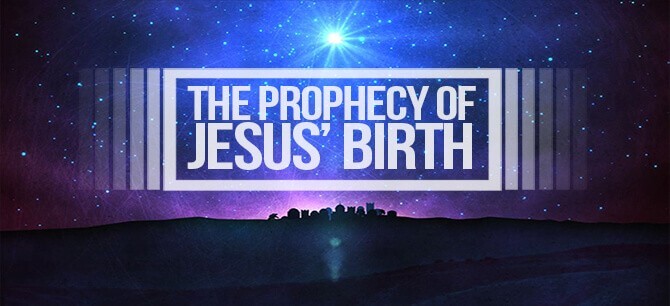
In his book, The Case for Christ, former Chicago Tribune journalist Lee Strobel
presents the compelling evidence which caused him to abandon his long-held
atheism for Christianity. One of the major arguments which convinced Mr.
Strobel of the deity of Christ was His fulfillment of Messianic prophecy. He writes:
“In many criminal cases, fingerprint identification is the
pivotal evidence. I remember covering a trial in which a single thumbprint
found on the cellophane wrapper of a cigarette package was the determining
factor in convicting a twenty-year-old burglar of murdering a college coed.
That’s how conclusive fingerprint evidence can be.
In the Old Testament, there are several dozen major
prophecies about the coming of the Messiah, who would be sent by God to redeem
His people. In effect, these predictions form a figurative fingerprint that
only the Anointed One would be able to match. This way, the Israelites could
rule out any impostors and validate the credentials of the authentic Messiah.
Against astronomical odds—one chance in a trillion, trillion,
trillion, trillion, trillion, trillion, trillion, trillion, trillion, trillion,
trillion, trillion, trillion—Jesus, and only Jesus throughout history matched
this prophetic fingerprint. This confirms Jesus’ identity to an incredible
degree of certainty.”[1]

As you study the birth narrative
of Christ, the Gospel writers make it abundantly clear that the Christ-child possesses
the Messianic fingerprint that the Old Testament prophets foretold centuries in
advance. Scholars have noted that there are over 300 prophecies concerning the
first advent of Christ, all of which were fulfilled precisely. Consider just a
few which pertain to Christmas:
·
Genesis 3:15, the
first prophecy in the Bible, predicted that the Redeemer would be born of a
woman. The text even hints at a virgin birth because it refers to the Redeemer
as “the seed of the woman,” a curious phrase since the Hebrew mind regarded the
“seed” of life to belong to the man. Somehow, this Redeemer would be conceived
without the help of a man. This prophecy was fulfilled in Luke 2:7 and Galatians 4:4.
·
Genesis 12:1-3
predicted that Messiah would be a descendant of Abraham. The fulfillment of
this is found in Jesus’ genealogy recorded in Matthew 1:1.
·
Genesis 21:12
showed that the Messiah could trace his lineage through Abraham’s son, Isaac
and then Numbers 24:17 added Jacob as well to the family tree. These are both
fulfilled in Matthew 1:2.
·
Genesis 49:10
narrows the focus of the Messiah’s ancestry even more by predicting that He
will come from the tribe of Judah, one of Jacob’s 12 sons. The fulfillment of
this is made clear once again in Matt. 1:2-3.
·
Two prophecies
show that the Messiah would have a legal claim to royalty as he would be a
descendant of Jesse, the father of David—Israel’s first king (Isaiah 11:1; Jeremiah
23:5-6). The fulfillment of these specifications are found in Luke’s genealogy
of Jesus (3:31-32) and in the angel’s announcement to Mary (Luke 1:32-33).
·
Daniel gave the
exact timetable for the Messiah’s appearance (Dan. 9:25). According to this
stunning prophecy the time for Messiah’s presentation to the nation would come
173,880 days from the day the decree was given for the Jewish people to return
from captivity to rebuild their temple, which occurred on March 5, 444 BC.
Moreover, Luke 2:1-2 sets the historical cross-hairs for the time of Jesus’ birth
during the rule of Caesar Augustus.
·
Isaiah 7:14
predicted that the Messiah would be born of virgin. This was confirmed in the angelic
announcement to Mary (Luke 1:26-27, 30-31).
·
Micah 5:2
foretold that the Christ would be born in the little town of Bethlehem. Caesar
didn’t know it, but his decree for all subjects in the Roman Empire to return
to their hometown to be counted for the census got Mary and Joseph from
Nazareth to Bethlehem so this prophecy could be fulfilled in Luke 2:4-5, 7.
·
Psalm 2:7 said
that Messiah’s identity as the “Son of God” would be announced at His birth.
This is exactly the announcement made by the angels to Mary (Luke 1:32) and the
shepherds (Luke 2:11).
·
Jeremiah
predicted a time when, because of Christ’s birth, many children would be
slaughtered (Jer. 31:15). We see this transpire when King Herod, “The Butcher
of Bethlehem,” killed the Jewish boys for fear of the newborn king (Matt.
2:16-18).
·
Hosea revealed
many centuries in advance that Mary, Joseph and Jesus would have to flee to
Egypt to escape the wrath of Herod (Hos. 11:1; Matt. 2:14-15).
As you can see many of
these prophecies would be impossible to fulfill by human manipulation or even
blind chance. How could one cause himself to be virgin born? How could someone
plan to be born in Bethlehem even though the family they chose lived in
Galilee? How could anyone engineer their birth so that it would occur in a specific
time and with a specific ancestry?
So staggering are these fulfilled
prophecies that one mathematician, Peter Stoner, calculated the chances of just
eight of these being fulfilled by chance as one in 1017 (10 to the
17th power). That is one in 100,000,000,000,000,000. To help us
comprehend this mind-boggling probability, Stoner illustrates with this
analogy.
Imagine filling the state
of Texas knee deep in silver dollars. Include in this huge number one silver
dollar with a red “X” mark on it. Then, turn a blindfolded person loose in this
sea of silver dollars. The odds that the first coin he would pick up would be
the one with the red "X" are the same as eight prophecies being
fulfilled accidentally in the life of Jesus.[2]
Considering those amazing,
but true facts, you would be a fool to conclude anything else than Bethlehem’s
babe as the baffling intersection of deity with humanity.

No comments:
Post a Comment